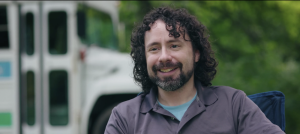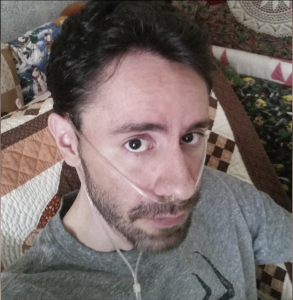IPF Patient, Three Lakes Foundation Join to Bring ‘Second Wind’ to Others

Nick Brown poses in front of his converted school bus. (Photo courtesy Three Lakes Foundation)
A partnership that may touch many in the pulmonary fibrosis community started with a chance meeting on a school bus. But it wasn’t the typical, long yellow vehicle with a fold-out stop sign that ferries children to school.
This bus had been turned into a second home for Nick Brown, an idiopathic pulmonary fibrosis patient with a double-lung transplant who had decided to take on a new hobby. He was an unofficial initiate into the club of people flipping school buses into RVs, who call themselves as “skoolies.”
Brown was sitting with the director of the new Three Lakes Foundation, a Chicago-based nonprofit that supports patients by working to improve research outcomes, available treatments, and the time to an accurate diagnosis, among other goals. For the next 30 minutes, Brown told his story: how a 36-year-old skilled metalworker from Indiana was diagnosed with pulmonary fibrosis, and almost two years later would have died if he hadn’t received a lung transplant.
“It was really powerful to hear a story from such a young person that experienced the symptoms and ultimately the diagnosis of pulmonary fibrosis,” said Dana Ball, director of the Three Lakes Foundation.
‘Second Wind’
Pulmonary fibrosis progresses differently depending on the patient, and for Brown — a self-described regular jogger and weight-lifter who lives in Indianapolis — it happened quickly.
Now 40, he said his symptoms started with a “tickle” in his throat, before progressing to a nagging cough. On a CT scan six months later, doctors discovered honeycombing, a hallmark of pulmonary fibrosis.
Brown went from needing one liter of oxygen per minute to 10, and eventually had to be placed on 60 liters. His weight dropped from about 160 to almost 100 pounds. The final step was hooking him up to an ECMO machine, which are artificial lungs that operate outside the body.
A short time later, on March 6, 2018, he received his new lungs.
“I call it the closest you can get to nirvana,” Brown said of taking a first breath with his healthy lungs.
Walking back from Brown’s bus and up the hill to the Pulmonary Fibrosis Foundation’s Summit 2019 in San Antonio, Texas, Ball decided to create a documentary about Brown.
“I remember all of us saying, at the same time, we have to do something about this, we need to hear Nick’s story and the world needs to hear Nick’s story,” Ball said in a video interview with Pulmonary Fibrosis News.
The Three Lakes Foundation, created three years ago and a 501(c)(3) since January, is hoping the resulting documentary, “Second Wind,” will help advance its mission by reminding people of the need to be aware of symptoms before it’s too late, and to educate others about organ donation.
Research focused
Brown’s journey is a good example of why awareness is part of the group’s mission. If doctors can catch pulmonary fibrosis early, they can start the patient on medication and other treatments to help slow disease progression.
In October, Three Lakes partnered with the Pulmonary Fibrosis Foundation for an online campaign called “More Than A Cough,” which urged people to get tested for pulmonary fibrosis even if their symptoms seemed mild. According to collected data, the promotional video has received 2.7 million views.
Once caught early, the disease can be managed through the use of anti-fibrotic treatments like Ofev (nintedanib), by Boehringer Ingelheim, and Esbriet (pirfenidone), by Genentech. These medications can help to prevent some of the scarring of PF, but no drugs can stop the disease from getting worse. The hope, at least for Ball, is that some patients might hold out long enough for a cure.
While not yet officially announced, Ball, who worked in the type 1 diabetes non-profit world for 15 years before taking the foundation’s helm in 2019, said the organization has a fully funded research consortium. A group of investigators will use lung tissue from pulmonary fibrosis patients to understand how the disease forms in humans. They will then aggregate their data and place it in a database available to academics and clinicians.
In the same vein of data analyses being used to understand the disease, the foundation also partnered with the Yale University School of Medicine to create the IPF Cell Atlas. It catalogs all the types of cell variations in idiopathic pulmonary fibrosis patients so that one day the various pathways behind the disease will be better understood.
All Aboard the Bus
Brown traveled to dozens of cities in the eastern half of the United States with his renovated school bus, visiting natural parks to hike and go caving. At the same time, he spreads awareness about pulmonary fibrosis through his blog, Borrowed Breaths.
“I started with the blog to bring encouragement to my fellow patients and be like, ‘hey, look, this is how sick I was,’” Brown said in the interview. “And, you know, life’s not perfect, but look how good I’m doing now.”
That’s not the website’s only purpose. It’s also a chance for him to update others on his outdoor adventures. Even before the current coronavirus outbreak, Brown had to be careful about where he went, as even the common cold could wreak havoc on his immune system. He compares the blog to a Yelp review, tailored to people with pulmonary fibrosis.
Brown painted his blog’s logo and URL on the pale blue trimming that spans the upper right side of his white bus. It’s made for both heightened awareness and free advertising. He’s gotten questions from interested people across the country. In one instance, Brown ran into another “skoolie” and had yet another chance to share his pulmonary fibrosis story.
And with his fledgling partnership with the Three Lakes Foundation, more is on the horizon. When it is safe to do so, Brown plans on visiting pulmonary fibrosis centers across the U.S. to talk with small groups of patients, helping them through their own difficulties.
“I remember what it’s like sitting there in that hospital bed, dying, wondering what was going to happen,” Brown said. “I feel like I connect with them. It just feels like a moral obligation.”









